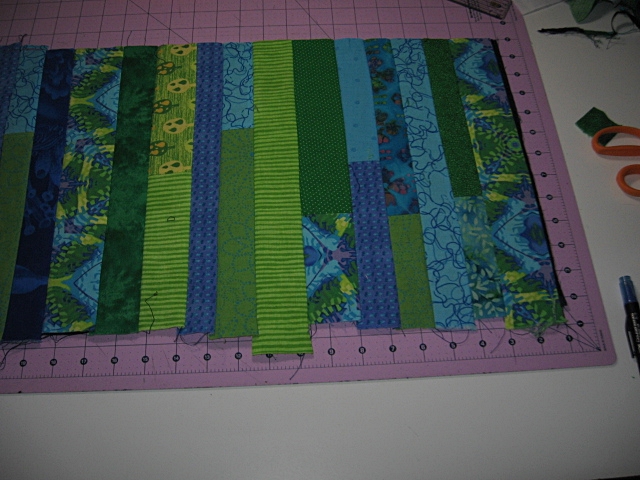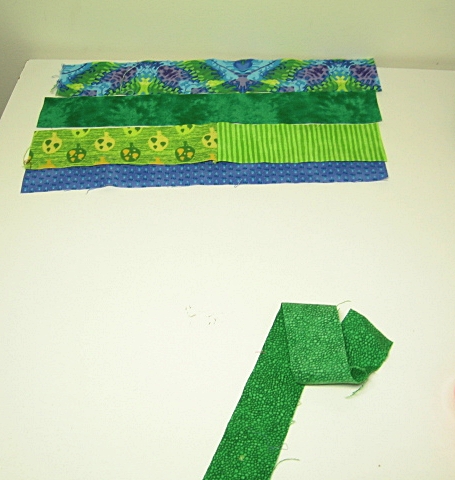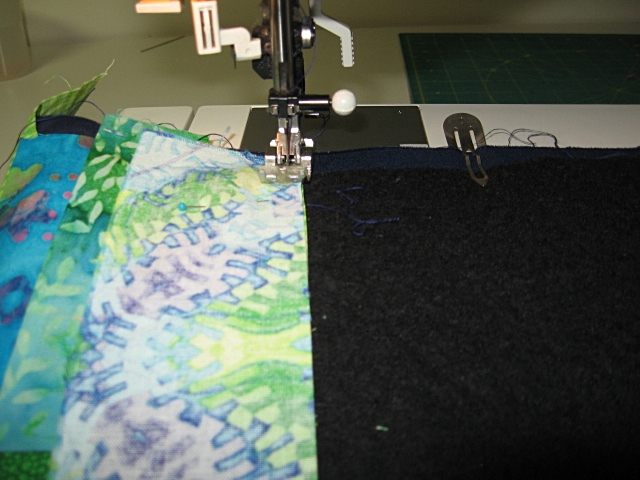Quilt as you go

Once I had found a piece of fabric large enough for the backing and cut a piece of batting the same size (12" X 34") I dug out a bunch of blue and green scrapes that I could cut to 13" lengths. I also found some scrapes that were not 13" but they felt like they belonged so I figured I could sew them together with a coordinating fabric to make a 13" strip and that would add a bit of visual interest rather than having all the stripes the same length. Once I had enough stripes cut that varied in width from 1 1/2" to 2 1/2" it was time to start designing the quilt top. Since my design wall is down in the basement and the sewing room is on the main floor, I laid out the stripes on the sewing table next to the machine. I layered the backing fabric with the batting and it was time to start sewing.
I took the first strip and came in slightly more than 1/4" on one end and with the strip hanging off the end of the batting, I sewing my first seam and then flipped it over so that the right side was up and pressed it. This made a nice seam right along the end of the piece and the small amount of the batting that could be seen would be covered by the binding. I then took the next strip, lined up the cut edges to the sewn strip's cut edge and with right sides together, sewed the next seam and then flipped and pressed. I also noticed that there was a bit of puckering on the backing so as I went along adding stripes and pressing each one, I also pressed the puckers out of the backing fabric. I found controlling the backing fabric a bit problematic since it tended to slip and not stay lined up with the batting. About half way through it had skewed quit a bit so I had to rip out a seam and reposition it. I tried clipping the backing fabric to the batting and repositioning the clips after ever strip. This did not work very well and the whole idea behind quilt as you go is that it is a speedy way for completing a project and this was anything but speedy. I found that if I pinned the strip that I was adding, it also pinned the backing in place and once I started pinning, it went more smoothly. I am now thinking that the next time I make a table runner that is long and skinny, I will use basting spray to attach the backing fabric to the batting. The master quilter I had talked to earlier in the day said she did not use basting spray but then again she has been doing this for 30 years. So, obviously I will experiment with the way that works best for me.
Once I had all the strips sewn in place it was time to trim the piece to it's final size. I knew starting out that it would be important to cut the strips slightly longer than the finished size. Due to the slight shifting of the backing fabric I had to trim another 1/4" from one of the sides so the final size of the project ended up being 11 3/4" by 32". My brain in now thinking about all the table runners and place mats I will be able to make using this nifty method.
- Sandy's blog
- Log in to post comments

 Click here to see us on Facebook
Click here to see us on Facebook  Follow Me on Pinterest
Follow Me on Pinterest


Comments
years ago Edna Harrington
years ago Edna Harrington (great quilter in Roxbury NY) made lots of scrap (not scrapes) quilts and she sewed them onto 16 inch square backing and later on into a big quilt. Not sure this helps but I thought I tell you about it.
Thought about puckering
When i have used this method for placemats I start in the middle and work out to both sides. I think it made the backing stay in place a bit easier. - Holly
Quilt as you go
I had a lot of fun sewing those blue and green scraps(not scrapes) into a column and even more delighted with the comments! I am having trouble visualizing how one would start in the middle and work in both directions since the first strip is sewn on and then flipped over and pressed and then the next one is laid on top of that one, sewn and flipped just like dominos. So Holly, could you provide me with a few more details? Thanks!